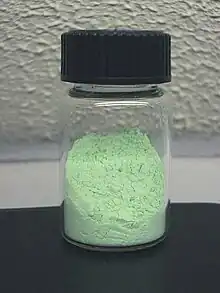Nickel(II) carbonate
Nickel(II) carbonate describes one or a mixture of inorganic compounds containing nickel and carbonate. From the industrial perspective, the most important nickel carbonate is basic nickel carbonate with the formula Ni4CO3(OH)6(H2O)4. Simpler carbonates, ones more likely encountered in the laboratory, are NiCO3 and its hexahydrate. All are paramagnetic green solids containing Ni2+ cations. The basic carbonate is an intermediate in the hydrometallurgical purification of nickel from its ores and is used in electroplating of nickel.[3]
 | |
 | |
| Names | |
|---|---|
| IUPAC name
Nickel(II) carbonate | |
| Other names
Nickelous carbonate | |
| Identifiers | |
| |
3D model (JSmol) |
|
| ChemSpider | |
| ECHA InfoCard | 100.020.063 |
| EC Number |
|
PubChem CID |
|
| RTECS number |
|
| UN number | 3288 |
CompTox Dashboard (EPA) |
|
| |
| |
| Properties | |
| NiCO3 | |
| Molar mass | 118.7 |
| Appearance | light green powder |
| Density | 4.39 g/cm3 |
| Melting point | 205 °C (401 °F; 478 K) decomposes[1] |
| 0.0093 g/100ml | |
Solubility product (Ksp) |
6.6·10−9 |
| Structure | |
| rhombohedral | |
| Hazards | |
| GHS labelling: | |
  [2] [2] | |
| Danger | |
| H302, H312, H315, H317, H319, H332, H334, H335, H350[2] | |
| P201, P261, P280, P305+P351+P338, P308+P313[2] | |
| NFPA 704 (fire diamond) | |
| Lethal dose or concentration (LD, LC): | |
LD50 (median dose) |
840 mg/kg |
| Safety data sheet (SDS) | ICSC 0927 |
Except where otherwise noted, data are given for materials in their standard state (at 25 °C [77 °F], 100 kPa).
Infobox references | |
Structure and reactions
NiCO3 adopts a structure like calcite, consisting of nickel in an octahedral coordination geometry.[4]
Nickel carbonates are hydrolyzed upon contact with aqueous acids to give solutions containing the ion [Ni(H2O)6]2+, liberating water and carbon dioxide in the process. Calcining (heating to drive off CO2 and water) of these carbonates gives nickel oxide:
- NiCO3 → NiO + CO2
The nature of the resulting oxide depends on the nature of the precursor. The oxide obtained from the basic carbonate is often most useful for catalysis.
Basic nickel carbonate can be made by treating solutions of nickel sulfate with sodium carbonate:
- 4 Ni2+ + CO32− + 6 OH− + 4 H2O → Ni4CO3(OH)6(H2O)4
The hydrated carbonate has been prepared by electrolytic oxidation of nickel in the presence of carbon dioxide:[5]
- Ni + O + CO2 + 6 H2O → NiCO3(H2O)4
Uses
Nickel carbonates are used in some ceramic applications and as precursors to catalysts.
Natural occurrence
The natural nickel carbonate is known as gaspéite - a rare mineral. Basic Ni carbonates also have some natural representatives.[6]
Safety
It is moderately toxic and causes low irritation. Avoid prolonged contact.
References
- https://www.conncoll.edu/media/website-media/offices/ehs/envhealthdocs/Nickel_Carbonate.pdf
- Sigma-Aldrich Co., Nickel(II) carbonate hydroxide tetrahydrate. Retrieved on 2014-05-06.
- Keith Lascelles, Lindsay G. Morgan, David Nicholls, Detmar Beyersmann, "Nickel Compounds" in Ullmann's Encyclopedia of Industrial Chemistry Wiley-VCH, Weinheim, 2005. doi:10.1002/14356007.a17_235.pub2
- Pertlik, F. (1986). "Structures of hydrothermally synthesized cobalt(II) carbonate and nickel(II) carbonate". Acta Crystallographica Section C. 42: 4–5. doi:10.1107/S0108270186097524.
- Handbook of Preparative Inorganic Chemistry, 2nd Ed. Edited by G. Brauer, Academic Press, 1963, NY. p. 1557.
- "Gaspéite".
